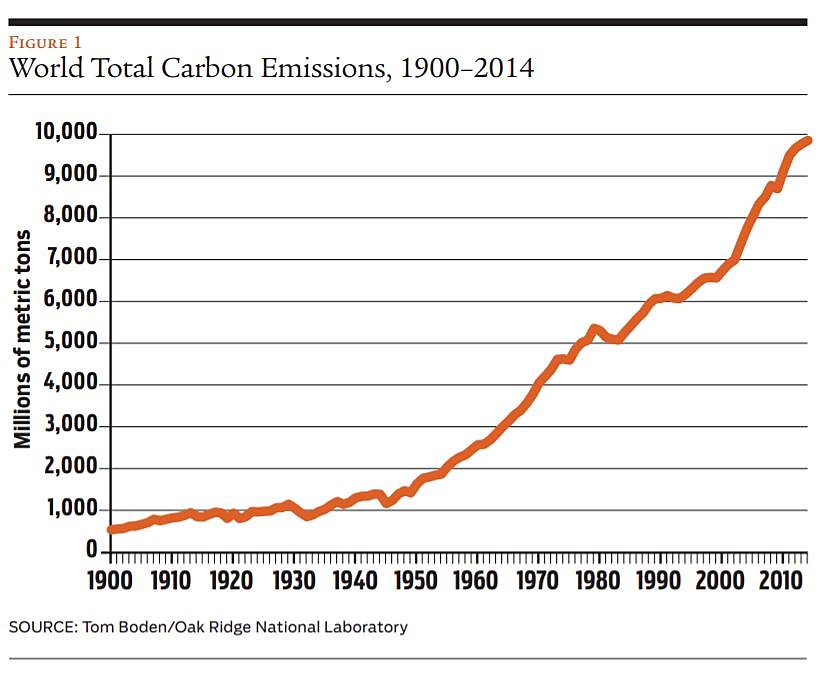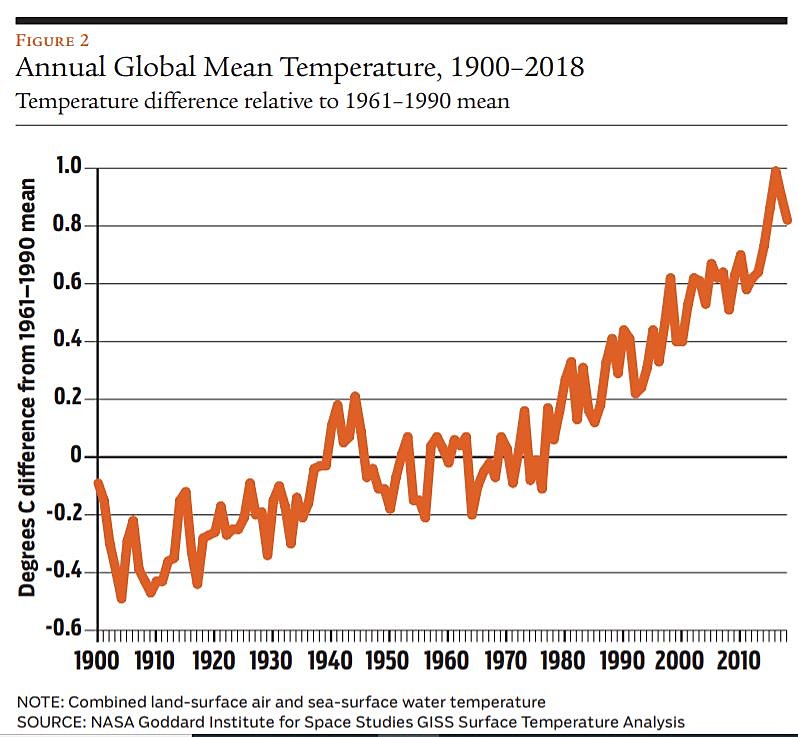Indeed, this policy trap—call it the “Climate-Change Doomsday Trap”—affords less hope of long-term survival for humanity than a person chest-high in quicksand, miles from the nearest town and without a cellphone. Moreover, just as struggling in quicksand can worsen a person’s fate, so can climate scientists’ dire warnings of a coming environmental Armageddon make its advent self-realizing and even more binding. The human race’s best hope of survival is that climate science and/or the economics of global warming have been exaggerated or are wrong in some fundamental and unrecognized way—which could be a long shot at best, given the binding economics of climate change.
The message for humanity hidden in the arcane details of the climate science narrative is one largely unacknowledged by climate scientists themselves: “Brace for doomsday.”
Climate Scientists’ Global Warming Arguments
Climate scientists start their case for abatement of greenhouse-gas emissions by establishing the chemical tie between those emissions and global warming. They then show that since the late 19th century, human-emitted greenhouse gases—mainly carbon dioxide (CO2)—have continued on a steep upward trend. To date, emissions-abatement programs have had little to no effect on the upward trek of global emissions, as apparent in Figure 1. This is complemented by the historical upward trek in global temperatures, shown in Figure 2. Most climate scientists express confidence in the causal tie between the data series in the two graphs, supported by the laws of chemistry and their many statistical models.
Having established a causal tie between emissions and global warming, climate scientists and climate-change policy advocates then enumerate a lengthy and growing list of the environmental and human consequences from past and future emissions. Among their claims:
- Earth’s average temperature has risen 1–2º Fahrenheit since the late 1800s, when humans began relying heavily on fossil fuels. Today, the planet is warmer than it has been in 120,000 years. The atmosphere has more CO2 in it than in tens of millions of years. Earth could warm another 2–3º by the end of this century. Global warming has been, and will continue to be, largely human-caused.
- The rise in the global temperature may not seem like much, but it has caused:
- glaciers around the globe and ice shelves and sea ice in the Arctic and Antarctic to retreat, melting at an escalating rate (although glaciers can ebb and flow in thickness with short-term cooling and warming with local temperatures) and threatening a “multi-meter rise” in sea level by the end of the century.
- sea levels to rise by three inches between 1993 and 2017 from melting ice and from heating of the oceans’ water. The rate of annual sea-level rise is also accelerating, putting tens of trillions of dollars of coastal properties around the globe in jeopardy and causing small, low-lying South Pacific islands to disappear below the waves.
- coral reefs to die and turn white, destroying vital habitats for sea life in the process, and
- polar bears, trees, butterflies, and other species to retreat in numbers, making more precarious their survival.
- Global warming has also fueled more frequent extreme and unpredictable global weather-patterns, realized in more frequent and powerful hurricanes and tornadoes, as well as more frequent and deadly droughts, floods, and forest fires that, in turn, have caused more deaths and property destruction.
- Global warming has also caused more tribal and national conflicts because of a growing scarcity in productive resources and more suicides because of mounting economic and emotional distress.
The list of harms from climate change lengthens with the escalating growth in climate-science studies. Climate scientists attest that the issue is no longer if human emissions are to blame for the various climate changes, but rather the extent to which they are at fault and the extent of the enormous damage that will befall the planet.
The Curse of the “Tipping Point”
The gremlin in climate scientists’ gloomy narrative is the prospect of a “tipping point”: an abrupt worsening in environmental change, looming in the next dozen years or (at most) the next few decades—if the tipping point has not already been reached. Once climate change has “tipped,” global warming (and an array of other changes in the global climate) will be self-perpetuating, self-accelerating, and irreversible, no matter how drastic the adopted future emissions-abatement policies are.
Climate scientists point to how reductions in sea ice and snow packs, past and future, will mean less of the sun’s rays will be reflected into space and more rays will be absorbed as heat by the oceans around the globe. This, in turn, will cause additional warming that will circumnavigate the globe via ocean currents.
They also stress how rising sea levels have added, and will continue to add, more ocean surface and more water evaporation, with the added water vapor—a powerful greenhouse gas—boosting global warming in two ways. First, the vapor will directly capture the heat from sunlight. Second, it will add to Earth’s cloud cover, which will reduce the reflected heat from sunlight bouncing off the planet’s surface and back into space. The additional captured heat will further escalate the melting of glaciers, ice shelves, and sea ice, which will increase the sea-level surface, further accelerating evaporation and global heating.
The accompanying melting of the Antarctic and Arctic permafrost has resulted in the exposure of a herd of long-extinct mammoth skeletons (some with hair and even flesh on the bones), a cause for celebration among paleontologists. However, the permafrost melt has also released, and will continue to release, millions of tons of long-trapped methane—yet another greenhouse gas, and one that is far more destructive to the atmosphere than CO2.
Beyond the tipping point, the release of these trapped gases will escalate with self-perpetuating and self-accelerating cycles of greenhouse-gas releases, higher temperatures, higher sea levels, more erratic and destructive weather patterns—and, of course, greater global warming. Humans can be counted on to give a boost to the self-perpetuating cycles by cranking up their air conditioners.
By sounding ever-more-dire alarms about global warming and the potential for runaway cycles of climate change, climate scientists themselves may be exacerbating global warming and hastening the advent of the tipping point, albeit inadvertently. Their doomsday scenario could cause many people to become fatalists and adopt the Alfred E. Neuman mantra, “What, me worry?” Scientists are saying there is no hope unless all of humanity dramatically changes its emissions ways, and soon. But that hasn’t happened and is highly unlikely to happen anytime soon. Instead, people will resign themselves to saying: “What’s the use? Order me an Escalade, and turbocharge it!”
Beyond the tipping point, many scientists say, there is one inevitable outcome: environmental Armageddon, at which point the climate will become so degraded that all of life will be hellish, if species can survive that long. Effectively, Earth will gradually become a second Venus, which at one time, long ago, was likely as habitable as Earth, but is not today because of its (natural, not man-made) greenhouse-gas self-perpetuating cycles. Venus’s surface temperature is now close to 900 degrees.
The Economics of Climate Change
Economists have long pointed to the fundamental human dilemma undergirding global warming (as well as all other forms of pollution): the “tragedy of the commons.” This emerges when people cannot be excluded from (and charged for) using a so-called “common-access resource” such as the atmosphere. Thus, they do not suffer personal costs for their use (and overuse) of the resource through, say, greenhouse-gas emissions. Without personal costs for their damage, people can be expected to use and overuse, if not abuse, the resource held in common. The problem is especially acute for the global atmosphere (which is more self-evident in city smog than global temperatures).

